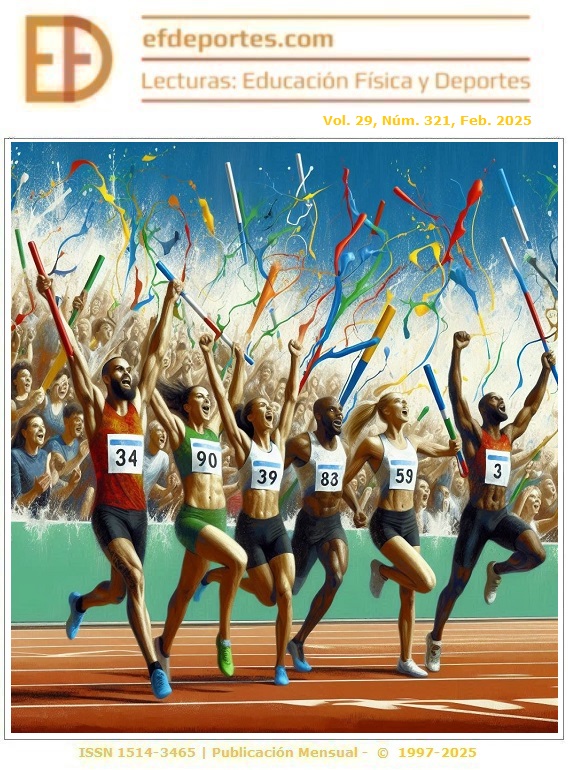Technological Hybridization in Non-Formal Physical Education
Challenges and Opportunities in the 21st Century
Abstract
The aim of this essay was to reflect on the transformations that digital technologies have generated in the practice of physical exercise and the role of the Physical Education teacher, mainly in the non-formal sector. Through an epistemological lens, it explores how the use of technological devices, such as smartwatches and monitoring apps, redefines not only physical activity but also the interactions between teachers and students in virtual environments. Drawing from excerpts of three works by different authors, it argues that the technological "device" is not merely a passive instrument but an active agent that modulates the relationship between the body and the environment. The text delves into the hybridization of the physical and digital realms, arguing that this fusion allows for new forms of pedagogical support that transcend the direct supervision of the teacher. Additionally, it highlights the opportunities and challenges arising from the virtualization of training, as well as the need for physical education professionals to acquire competencies in the use of digital technologies. Finally, it emphasizes that this change is not merely technical but involves an epistemological and professional transformation that redefines the boundaries of the professional field, social interactions and motor skills in non-formal Physical Education of the 21st-century.
References
Bonicatto, M., Chillemi, A., Iparraguirre, M.M., y Canelo, N.L. (2024). “Presencialidad remota”: una nueva oportunidad de ampliar las estrategias de accesibilidad para estudiantes universitarios/as. En Escenarios y recorridos educativos (1ra Edición, pp. 74-82). Dirección general de educación a distancia y tecnologías UNLP.
Cáceres Zapatero, M.D., Brändle Señán, G., y Ruiz San Román, J.A. (2017). Sociabilidad virtual: la interacción social en el ecosistema digital. Historia y comunicación social, 22(1), 233-247. https://doi.org/10.5209/HICS.55910
Candelero, N. (2013). De las obras que hacen. El camino de la materia, hacia la conciencia. III Jornadas Imágenes de la urbe: flujos culturales y políticas cotidianas. Centro de Estudios Teórico-Críticos sobre Arte y Cultura en Latinoamérica (CETCACL), Facultad de Humanidades, UNR.
Castro-Palomino, L., y Alanya Coras, E. (2024). Herramientas digitales en el desempeño de los docentes: revisión sistemática. Horizontes. Revista de Investigación en Ciencias de la Educación, 8(32), 288–299. https://doi.org/10.33996/revistahorizontes.v8i32.723
Cook, S. (2022). Running with a bag: Encumbrance, materiality and rhythm. Social & Cultural Geography, 24(7), 1104-1122. https://doi.org/10.1080/14649365.2022.2052169
Costa, F. (2021). Tecnoceno: Algoritmos, biohackers y nuevas formas de vida. Editorial Taurus.
Díaz Barahona, J. (2020). Retos y oportunidades de la tecnología móvil en la educación física. Retos: Nuevas Perspectivas de Educación Física, Deporte y Recreación, 37. http://doi.org/10.47197/retos.v37i37.68851
Faisal, I.A., Purboyo, T.W., y Ansori, A.S.R. (2020). A review of accelerometer sensor and gyroscope sensor in IMU sensors on motion capture. J. Eng. Appl. Sci, 15(3), 826-829. https://doi.org/10.36478/jeasci.2020.826.829
Flores Alarcia, O., del Arco Bravo, I. (2013). Nativos digitales, inmigrantes digitales: rompiendo mitos. Un estudio sobre el dominio de las TIC en profesorado y estudiantado de la Universidad de Lleida. Bordón: revista de pedagogía, 65(2), 59-74. https://recyt.fecyt.es/index.php/BORDON/article/view/brp.2013.65204
Gomez-Zorita, S., y Urdampilleta, A. (2012) Empleo de medias de compresión en el deporte: evidencia científica. Lecturas: Educación Física y Deportes, 17(175). https://www.efdeportes.com/efd175/empleo-de-medias-de-compresion-en-el-deporte.htm
Gould, S.J. (2006). El camino de en medio. En El pulgar del panda (pp. 65-75). Editorial Crítica.
Hasiuk, A., Jaszczur-Nowicki, J., Granda T., Potocka-Mitan, M., Perlinski, J., Guodong, Z., Kruckzkowski, D., y Burkowska, JM (2023). Effect of wearing high heels on the biomechanical parameters of the foot. Journal of Kinesiology and Exercise Sciences, 33(103), 8-17. https://doi.org/10.5604/01.3001.0053.8076
Helsen, K., Janssen, M., Vos, S., y Scheerder, J. (2022). Two of a Kind? Similarities and differences between runners and walkers in sociodemographic characteristics, sports related characteristics and wearable usage. International Journal of Environmental Research and Public Health, 19(15), 9284. https://doi.org/10.3390/ijerph19159284
Hijós, M.N. (2018). ‘Todos podemos ser corredores?”: un análisis sobre la comunidad runner y su vínculo con el mercado. Arquivos em Movimento, 14(2), 22-38. https://revistas.ufrj.br/index.php/am/article/view/14464
Monguillot, M., González Arévalo, C., y Guitert, M. (2017). El whatsapp como herramienta para la colaboración docente. EmásF: revista digital de educación física, 44. https://dialnet.unirioja.es/servlet/articulo?codigo=5807534
Mujica-Johnson, F.N., y Salgado López, J.I. (2021). Cultura, emociones y aprendizaje significativo en Educación Física. Ensayos pedagógicos, 16(2), 63-82. http://doi.org/10.15359/REP.16-2.4
Popper, K., Lorenz, K., y Kreuzer, F. (1992). El porvenir está abierto. Conversación al amor de la lumbre entre Konrad Lorenz y Karl R. Popper. En Metatemas. Libros para pensar la ciencia (3ra Edición, pp. 13-60). Tusquets Editores.
Radetich Filinich, N. (2023). La smartphonización de la vida social. Cuestiones de Sociología, 27, e148. https://doi.org/10.24215/23468904e148
Ráthonyi, G., Müller, A., y Rathonyi-Odor, K. (2018). How digital technologies are changing sport? APSTRACT: Applied Studies in Agribusiness and Commerce, 12, 89-96. https://doi.org/10.22004/ag.econ.292396
Salgado López, J.I., y García Arnoso, A. (2018). Uso da tableta dixital en EF: Estudo dunha experiencia práctica. Eduga: revista galega do ensino, 76. https://dialnet.unirioja.es/servlet/articulo?codigo=6996602
Sancio, D.R., Solans, M.I., López, E., Liotta, L.G., y Duró, M.V. (2022). Adopción y uso de tecnologías portátiles por parte de corredores recreacionales y entrenadores. Revista Integración + Divulgación de trabajos científicos, (2), 201-215. http://revistadigital.ucu.edu.ar/index.php/secytucu/article/view/45
Seçkin, A.Ç., Ateş, B., y Seçkin, M. (2023). Review on Wearable Technology in sports: Concepts, Challenges and opportunities. Applied Sciences, 13(18), 10399. https://doi.org/10.3390/app131810399
Serri, M. (2018). Redes sociales y Salud. Revista chilena de infectología, 35(6). http://dx.doi.org/10.4067/S0716-10182018000600629
Silva, L.M. da, Matias, N.F. de A., Silva, R.M., y Santos, M.P.M. dos (2024). A Era Digital da Educação: impactos e transformações no âmbito educacional sob a ótica dos professores. Revista Ibero-Americana de Humanidades, Ciências e Educação, 10(9), 3877-3891. https://doi.org/10.51891/rease.v10i9.15859
Van Dijck, J. (2016). La cultura de la conectividad: una historia crítica de las redes sociales. Siglo XXI editores.
Weineck, J. (2005). Entrenamiento Total. Editorial Paidotribo.
Yawar, A., y Lieberman, D.E. (2024). Effects of shoe heel height on ankle dynamics in running. Scientific Reports, 14(1), 17959. https://doi.org/10.1038/s41598-024-68519-z
Copyright (c) 2025 Lecturas: Educación Física y Deportes

This work is licensed under a Creative Commons Attribution-NonCommercial-NoDerivatives 4.0 International License.









